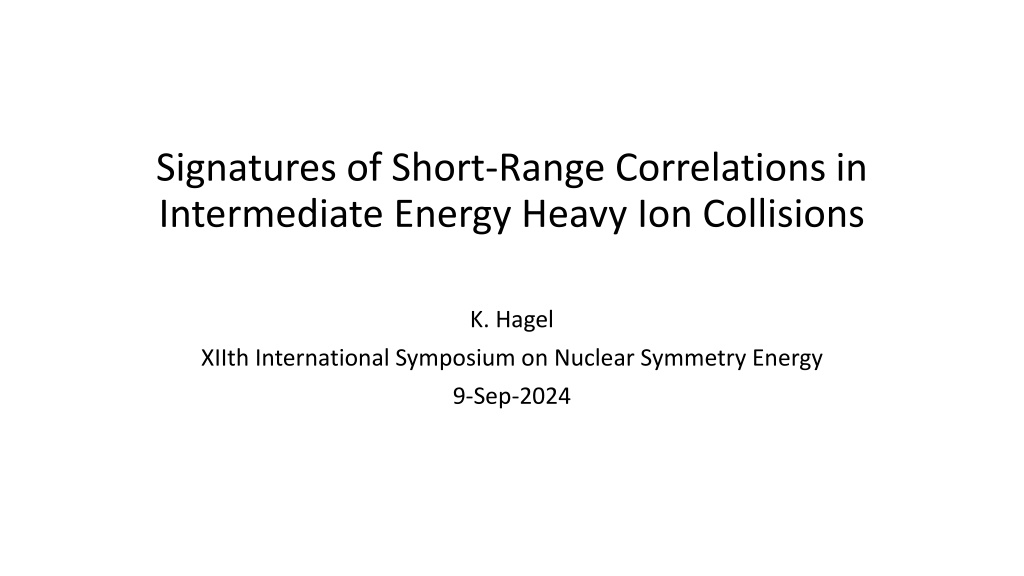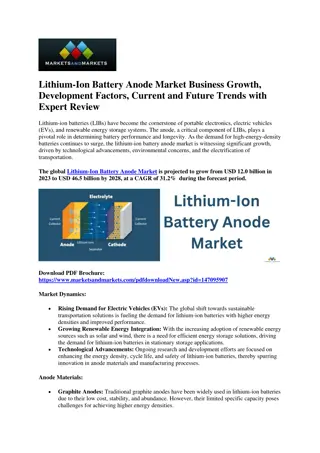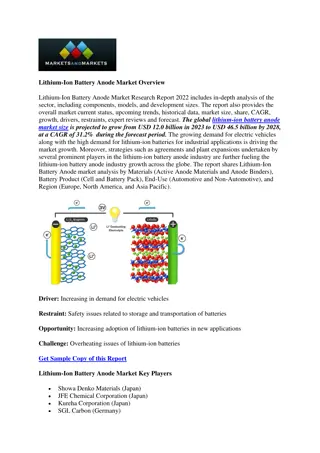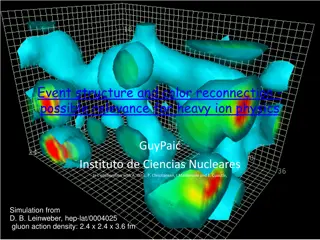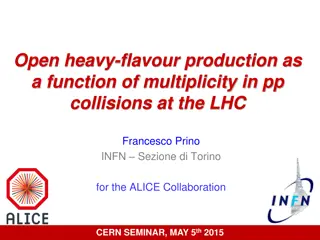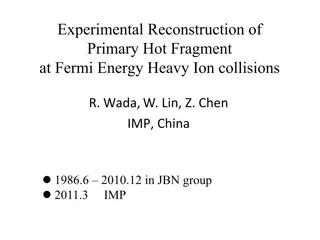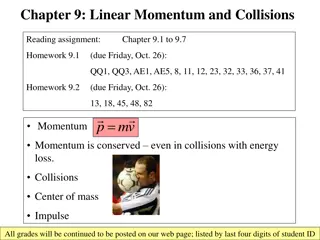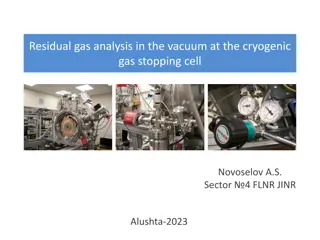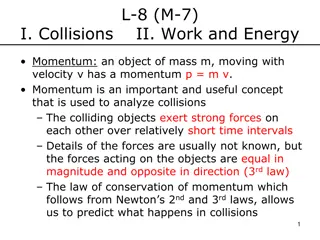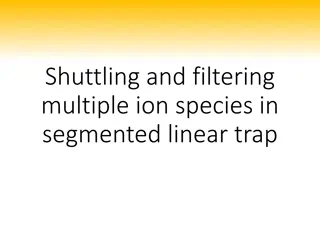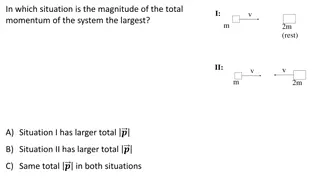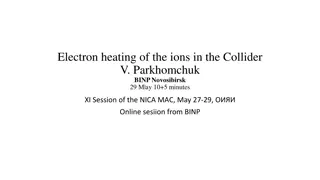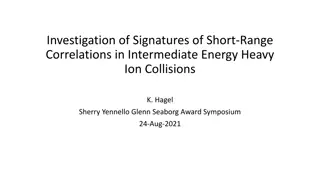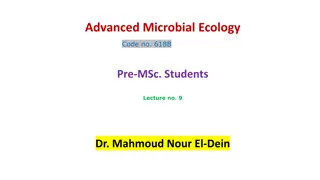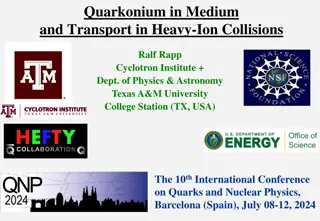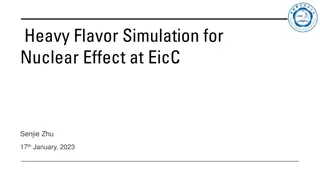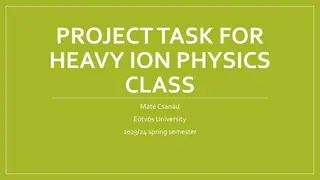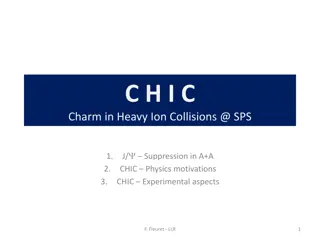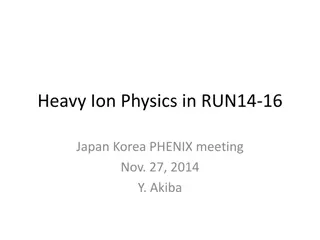Short-Range Correlations in Heavy Ion Collisions
Short Range Correlations in Nuclei Fluctuations of close proximity nucleon pairs. Small center of mass momentum, large relative momentum, important in investigation of large relative momentum and short distance properties of nuclear wave functions. Unexplored dynamics of nuclear repulsive core and insight into Neutron Star masses with SRCs included. Early theoretical work emphasizes importance of SRCs and properties of short-range interactions. Understanding the impact of SRCs on Symmetry Energy and their significance in studying cold dense nuclear systems.
Download Presentation

Please find below an Image/Link to download the presentation.
The content on the website is provided AS IS for your information and personal use only. It may not be sold, licensed, or shared on other websites without obtaining consent from the author.If you encounter any issues during the download, it is possible that the publisher has removed the file from their server.
You are allowed to download the files provided on this website for personal or commercial use, subject to the condition that they are used lawfully. All files are the property of their respective owners.
The content on the website is provided AS IS for your information and personal use only. It may not be sold, licensed, or shared on other websites without obtaining consent from the author.
E N D
Presentation Transcript
Signatures of Short-Range Correlations in Intermediate Energy Heavy Ion Collisions K. Hagel XIIth International Symposium on Nuclear Symmetry Energy 9-Sep-2024
Short Range Correlations in Nuclei Fluctuations of close proximity nucleon pairs. Small center of mass momentum Large relative momentum Important in the investigation of large relative momentum and short distance ( 1.2 fm) properties of nuclear wave functions Domain of transition from baryonic to quark gluon degrees of freedom New phenomena inherent to QCD dynamics that are not visible to long-range nuclear forces. Chiral symmetry, quark interchanges, gluon dynamics, and hidden color states, among others. Dynamics of the nuclear repulsive core Practically unexplored Ann. Rev. Nucl. Part. Sci. 67, 129 (2017) Insight into Neutron Star masses when SRC included in nucleon interactions in Dark Matter calculations Accessible to study in the lab Phys. Rev. D 105, 023008 (2022) Short Range Correlations ~Rnucleon Long Range Correlations ~Rnucleus Momentum space p1 Coordinate space 2N (np)- SRC p2 p1>pF ~1fm p2>pF
Early theoretical work Importance of Short Range Correlations first emphasized by Jastrow (Phys. Rev. 98, 1479 (1955)). Variational methods to estimate upper limit of the ground-state energy fails for the strong interaction Range comparable with the size of the nucleon, r0. Added NN correlations at r r0 Dilute nucleon gas Calculate momentum distribution at zero temperature of a dilute Fermi gas with repulsive interactions Simple model of a dilute nucleon gas yields 1/k4 dependence for k>kF 2 3 1 W. Czyz and K. Gottfried, Nucl. Phys. 21, 676 (1961) k/kF
Properties of short range interactions Universal feature of short-range interaction Probability of fermion to have k>kF larger for minority (protons in case of neutron rich nuclei) than majority Larger fraction of majority fermions in low k states. Short range interaction populates high k tail with equal majority and minority fermions np-pair dominance causes a greater fraction of protons than neutrons to have high momentum in neutron-rich nuclei O. Hen, et al., Science 346, 6209 (2014). M. Duer, O. Hen, et al., Nature 560, 617 (2018). Phys. Rev. Lett. 90, 042301 (2003)
Importance of SRCs to understand Symmetry Energy In general strongly correlated neutron-proton pairs can modify the internal structure of the nucleus and symmetry energy arises from imbalance of p-n in the nucleus Tensor force governs SRCs as well as buildup of symmetry energy Implications for understanding cold dense nuclear systems neutron stars Dark Matter
Microscopic perspective Correlated pn pairs 92% compared to 4% pp/nn correlations Tensor force impacts mostly np channel Effects of tensor correlations. Tensor force plays chief role in buildup of symmetry energy Calculations Broad spectrum of interactions Relativistic meson theory (most repulsive) to chiral forces (softer) with different UV scales. Chiral potentials with larger cutoff softer EOS of symmetric nuclear matter more repulsive with increasing cutoff Faster rate than neutron matter High density behavior of symmetry energy impacted by nature of nuclear force at high momentum Phys. Rev. C 90, 064312 (2014).
Nuclear Pasta One missing ingredient in pasta calculations is the inclusion of short-range correlations (SRC). Strongly correlated neutron-proton pairs can modify the internal structure of the nucleus and generate a series of non-trivial consequences. Calculations with different parameterizations with and without effects of SRCs included. NL3: much larger slope of symmetry energy than the other parameterizations Slope (L) as well as symmetry energy as a function of density dependent on whether or not SRC incorporated into calculation. Eur. Phys. J. A 59 209 (2023)
Cold nucleonic matter Average nucleon kinetic energy extracted from electron-nucleus scattering experiments cannot be reproduced by traditional RMF models lacking correlations. Including the SRC-induced high-momentum nucleons in the RMF model, the data can be well reproduced. SRC-modified single-nucleon momentum distribution is found to make the EOS of SNM much harder at suprasaturation densities and the Esym( ) more concave around 0, leading to a larger maximum mass of neutron stars Maximum mass still below observation EOS with HMT brings the prediction closer to observation.. Phys. Rev. C 93 014619 (2016)
Dark Matter and Neutron Stars Concerning the possibility of a description of neutron stars with some content of dark matter. Certain range for kFDM that produces mass-radius diagrams compatible with recent observations Effect of SRC in the DM matter model coupled to the hadronic one. Increasing the dark matter content in the system, i.e., by growing kFDM, softens EOS In principle, a conflict between the existence of DM in neutron stars and the possibility that these compact astrophysical objects attain higher mass values. Inclusion of SRC in hadronic models models with SRC become stiffer and because of that, they can describe more massive stars in comparison with those without this effect SRC can balance the decreasing of the neutron star mass due to the inclusion of DM in the system. Phys. Rev. D 105 023008 (2022)
Observing Short Range Correlations Pickup reactions, stripping, and electron and proton scattering Typically done using high energy beams 5.014-GeV electron beam incident on 12C, 27Al, 56Fe, and 208Pb targets CLAS at Jefferson Lab Electron-induced two-proton knockout reactions 5.9, 8.0 and 9.0 GeV/c p + 12C Can SRC be observed in intermediate energy Heavy Ion Reactions? Science 346, 6209 (2014). Phys. Rev. Lett. 90, 042301 (2003)
Evidence for SRC in Intermediate HI collisions Do HMTs manifest themselves in existing data? Hard photons Do not suffer from final state interactions Energy spectra show imprints on shape of nucleon HMTs Theoretical study of the interplay between SRC and symmetry energy. Effects of the SRC overwhelm those owing to the Esym( ). Calculated at 45 MeV/u Ca + 112Sn PRC 96, 064614 (2017) PRC 104, 034603 (2021); data from PRL 57, 555 (1986)
Can particle spectra from intermediate energy heavy ion reactions carry information on Short Range Correlations? 44 MeV/u Ar + V Proton energy spectra extend to more than twice the kinematic limit of first chance N-N collision Presence of high momentum tails? 14o 83o 158o R. Coniglione et al., Phys. Lett. B 471, 339 (2000)
Experiment Reactions: 4He, 10B, 20Ne, 40Ar, 64Zn + 112,124Sn Beam Energy: 47 MeV/u Proton spectra at = 4.3o PLF source T set to 4 MeV Data enhanced at high energies relative to fit Transform Energy spectra to wavenumber (k = p/ ) in PLF frame vsource = vp
Exploring possible k-4 dependence ?2? ? ??~?? 4 ?4?2? ? ??~? If then Spectrum constant or perhaps leveling off
Proton k spectra (projectile frame) k4d2M/d dk levels off for k > 0.8 fm-1 Consistent with 1/k4 dependence Fit is consistent (as it must be) 64Zn distribution may begin to fall faster than 1/k4 at k > 1.1fm4
Conclusions Symmetry Energy Trends in symmetry energy is dependent on treatment of Short Range correlations Possible signatures at intermediate energy heavy ion collisions (26 47 MeV/u) Proton distributions at forward angles consistent with 1/k4 dependence at large k 47 MeV/u data shows the signatures more convincingly Signature less certain at lower energies Strength of signature appears dependent on projectile/target asymmetry. Outlook Neutron experiment to attempt to detect the partner Probably difficult at these energies
Collaborators J. B. Natowitz, L. Qin, R. Wada, K. Hagel, Z. Chen, M. Huang, J. Wang, S. Kowalski, M. Barbui, D. Fabris, M. Lunardon, S. Moretto, G. Nebbia, S. Pesente, V. Rizzi, G. Viesti, M. Cinausero, G. Prete, T. Keutgen, Y. El Masri, Z. Majka, and Y. G. Ma,
k-4 scaling of momentum dependence of SRC nuclear-mass dependence of the number of SRC pp and pn pairs in nuclei can be described by tensor operators acting on NN pairs in a nodeless relative S state of the mean-field basis. This very-short-range behavior of the correlated part of the NN interaction leads to k 4 momentum dependence at high momentum Arises from the importance of the one-pion-exchange (OPE) contribution to the tensor potential VT , acting in second order. ?00?,? ?16?4 4?4 ?2??? ?? + ?2?02(?,?)?20(?,? )~????? Signature of short range interaction Necessary and sufficient condition for asymptotic two-nucleon wave function ~1/k2 and momentum density n(k) ~ 1/k4
